Financial Reporting: Goodwill and Intangible Assets for West Ltd
VerifiedAdded on 2021/02/20
|10
|2853
|27
Report
AI Summary
This report provides a comprehensive analysis of goodwill and intangible assets within the context of West Ltd. It delves into the specifics of AASB 138, the Australian accounting standard that governs the recognition and measurement of intangible assets, including goodwill. The report examines the accounting treatment of both internally generated and purchased goodwill, including amortization periods and impairment assessments. Furthermore, the report explores the impact of environmental considerations on West Ltd's goodwill, particularly its commitment to sustainable fishing practices and brand recognition. It also covers the financial implications of providing guarantees, the valuation of brands like Arctic Fresh and Tropical Taste, and the overall financial reporting of these intangible assets. The report concludes by summarizing the importance of accurate financial reporting and the role of accounting standards in ensuring transparency and fair presentation of a company's assets.
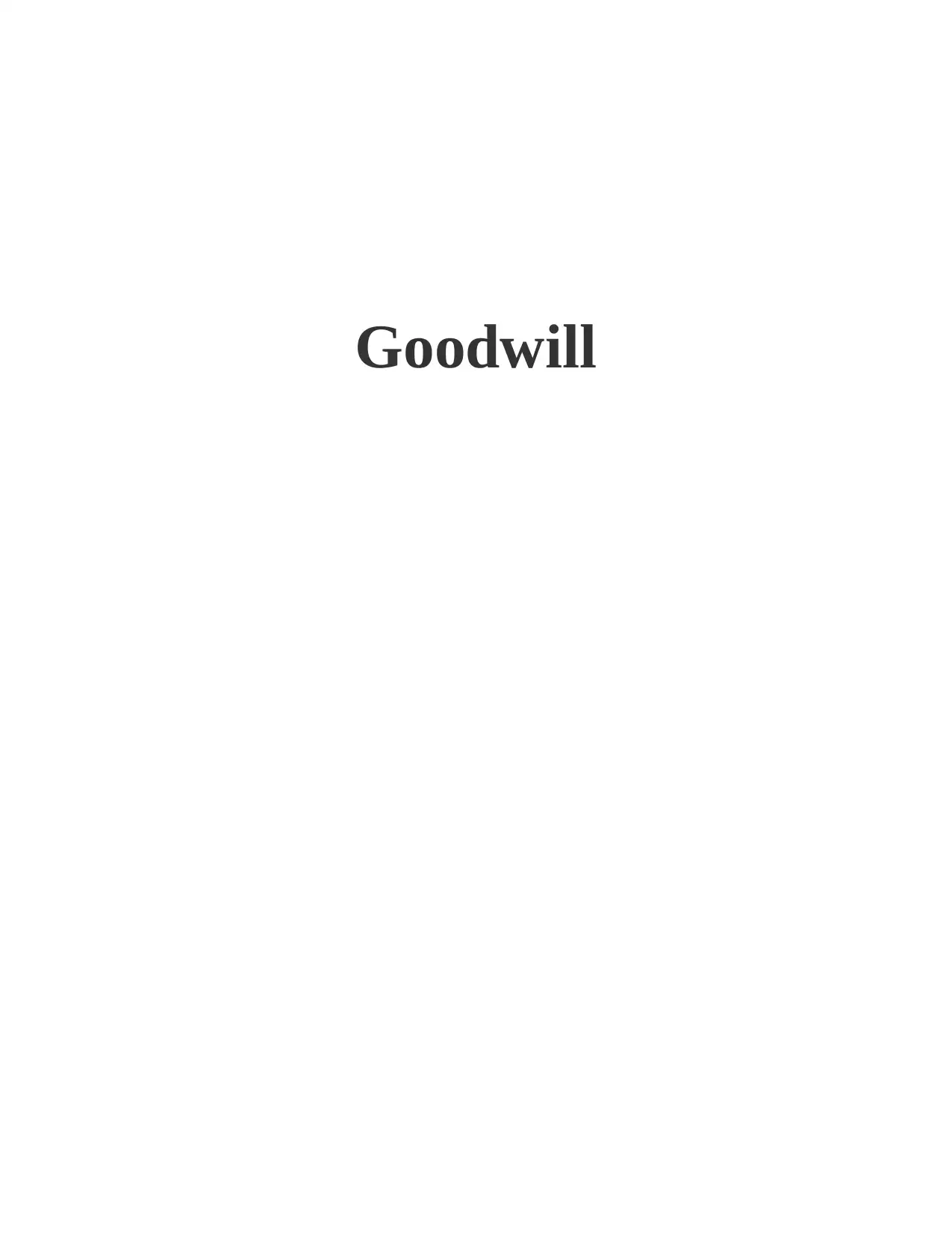
Goodwill
Paraphrase This Document
Need a fresh take? Get an instant paraphrase of this document with our AI Paraphraser
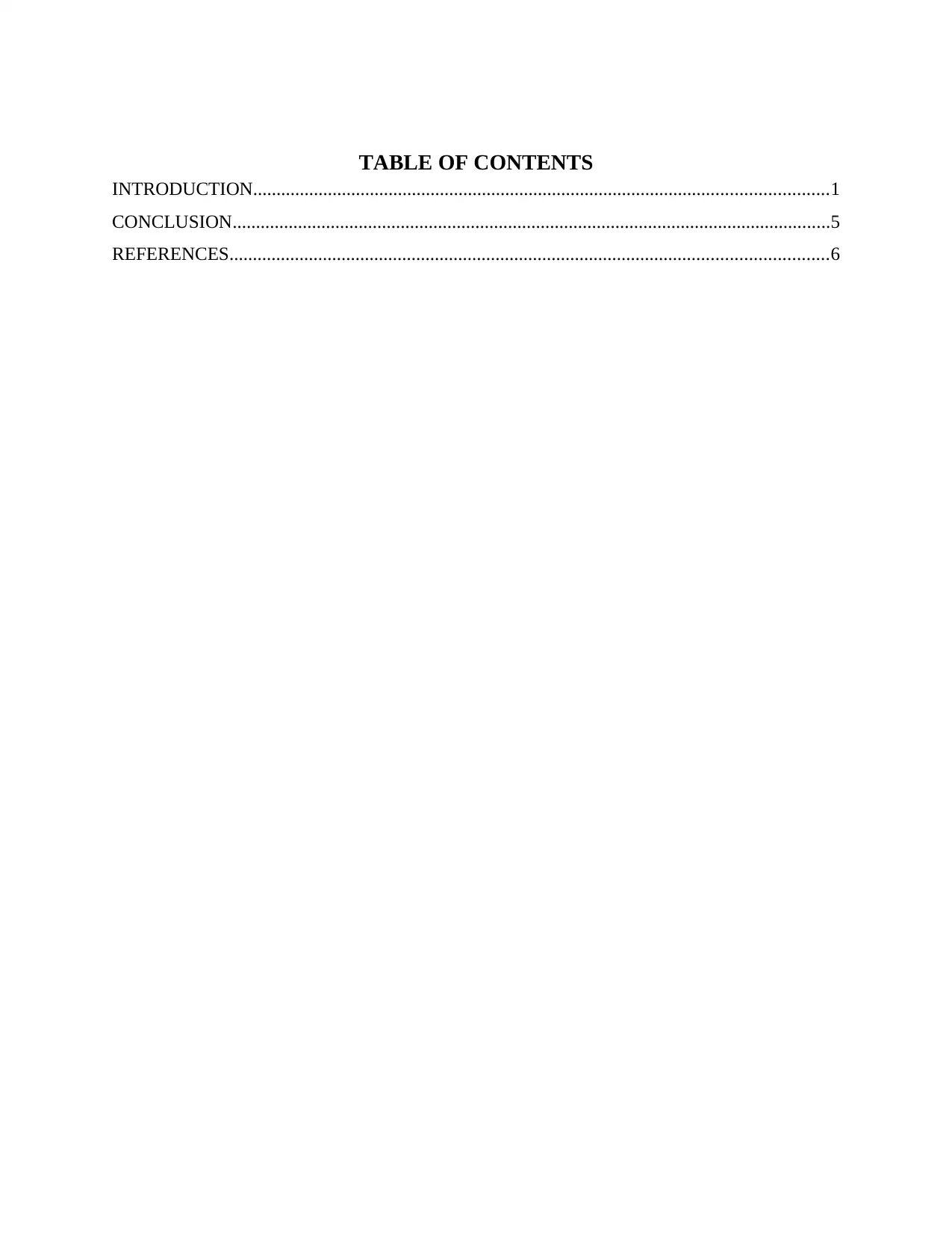
TABLE OF CONTENTS
INTRODUCTION...........................................................................................................................1
CONCLUSION................................................................................................................................5
REFERENCES................................................................................................................................6
INTRODUCTION...........................................................................................................................1
CONCLUSION................................................................................................................................5
REFERENCES................................................................................................................................6
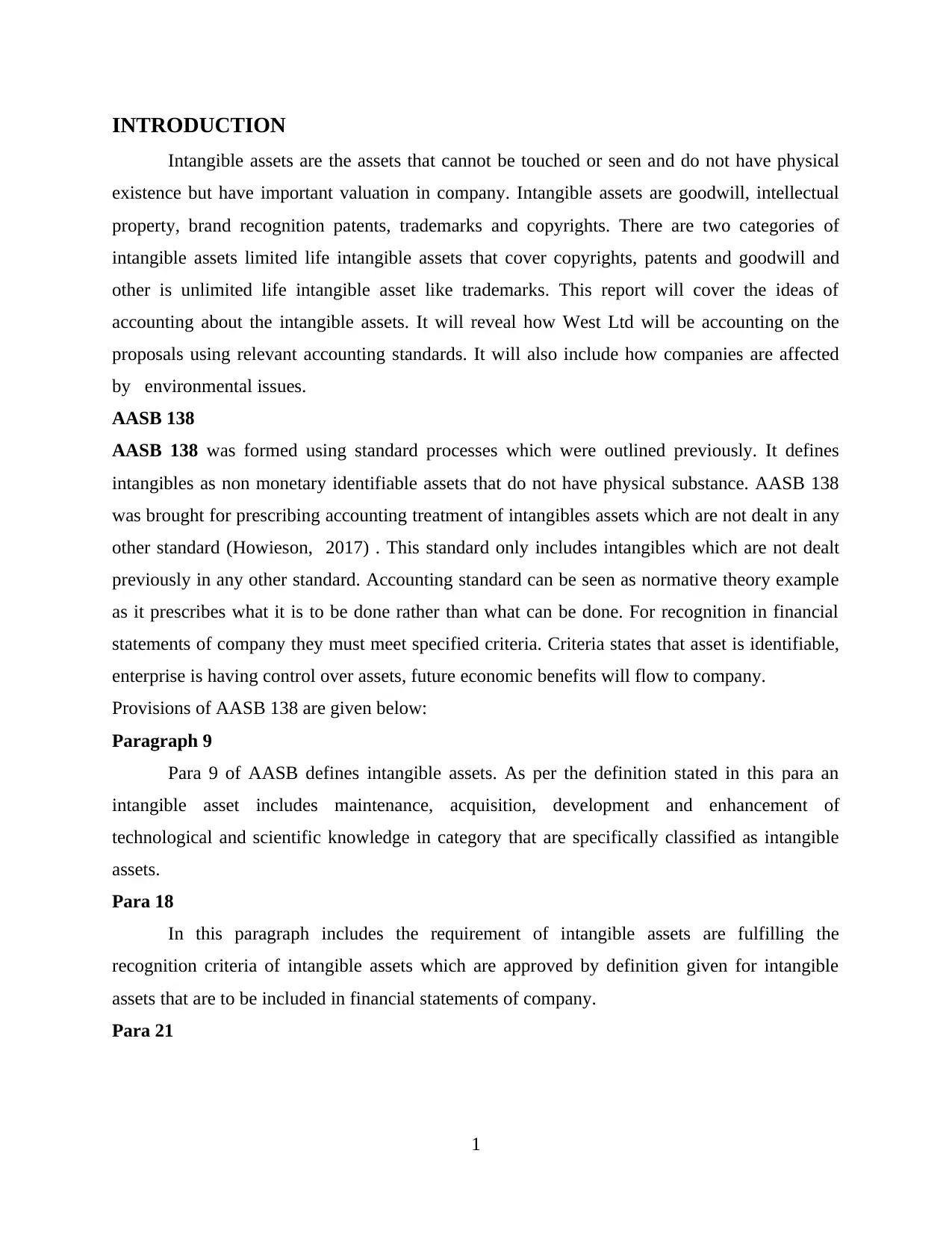
INTRODUCTION
Intangible assets are the assets that cannot be touched or seen and do not have physical
existence but have important valuation in company. Intangible assets are goodwill, intellectual
property, brand recognition patents, trademarks and copyrights. There are two categories of
intangible assets limited life intangible assets that cover copyrights, patents and goodwill and
other is unlimited life intangible asset like trademarks. This report will cover the ideas of
accounting about the intangible assets. It will reveal how West Ltd will be accounting on the
proposals using relevant accounting standards. It will also include how companies are affected
by environmental issues.
AASB 138
AASB 138 was formed using standard processes which were outlined previously. It defines
intangibles as non monetary identifiable assets that do not have physical substance. AASB 138
was brought for prescribing accounting treatment of intangibles assets which are not dealt in any
other standard (Howieson, 2017) . This standard only includes intangibles which are not dealt
previously in any other standard. Accounting standard can be seen as normative theory example
as it prescribes what it is to be done rather than what can be done. For recognition in financial
statements of company they must meet specified criteria. Criteria states that asset is identifiable,
enterprise is having control over assets, future economic benefits will flow to company.
Provisions of AASB 138 are given below:
Paragraph 9
Para 9 of AASB defines intangible assets. As per the definition stated in this para an
intangible asset includes maintenance, acquisition, development and enhancement of
technological and scientific knowledge in category that are specifically classified as intangible
assets.
Para 18
In this paragraph includes the requirement of intangible assets are fulfilling the
recognition criteria of intangible assets which are approved by definition given for intangible
assets that are to be included in financial statements of company.
Para 21
1
Intangible assets are the assets that cannot be touched or seen and do not have physical
existence but have important valuation in company. Intangible assets are goodwill, intellectual
property, brand recognition patents, trademarks and copyrights. There are two categories of
intangible assets limited life intangible assets that cover copyrights, patents and goodwill and
other is unlimited life intangible asset like trademarks. This report will cover the ideas of
accounting about the intangible assets. It will reveal how West Ltd will be accounting on the
proposals using relevant accounting standards. It will also include how companies are affected
by environmental issues.
AASB 138
AASB 138 was formed using standard processes which were outlined previously. It defines
intangibles as non monetary identifiable assets that do not have physical substance. AASB 138
was brought for prescribing accounting treatment of intangibles assets which are not dealt in any
other standard (Howieson, 2017) . This standard only includes intangibles which are not dealt
previously in any other standard. Accounting standard can be seen as normative theory example
as it prescribes what it is to be done rather than what can be done. For recognition in financial
statements of company they must meet specified criteria. Criteria states that asset is identifiable,
enterprise is having control over assets, future economic benefits will flow to company.
Provisions of AASB 138 are given below:
Paragraph 9
Para 9 of AASB defines intangible assets. As per the definition stated in this para an
intangible asset includes maintenance, acquisition, development and enhancement of
technological and scientific knowledge in category that are specifically classified as intangible
assets.
Para 18
In this paragraph includes the requirement of intangible assets are fulfilling the
recognition criteria of intangible assets which are approved by definition given for intangible
assets that are to be included in financial statements of company.
Para 21
1
⊘ This is a preview!⊘
Do you want full access?
Subscribe today to unlock all pages.

Trusted by 1+ million students worldwide
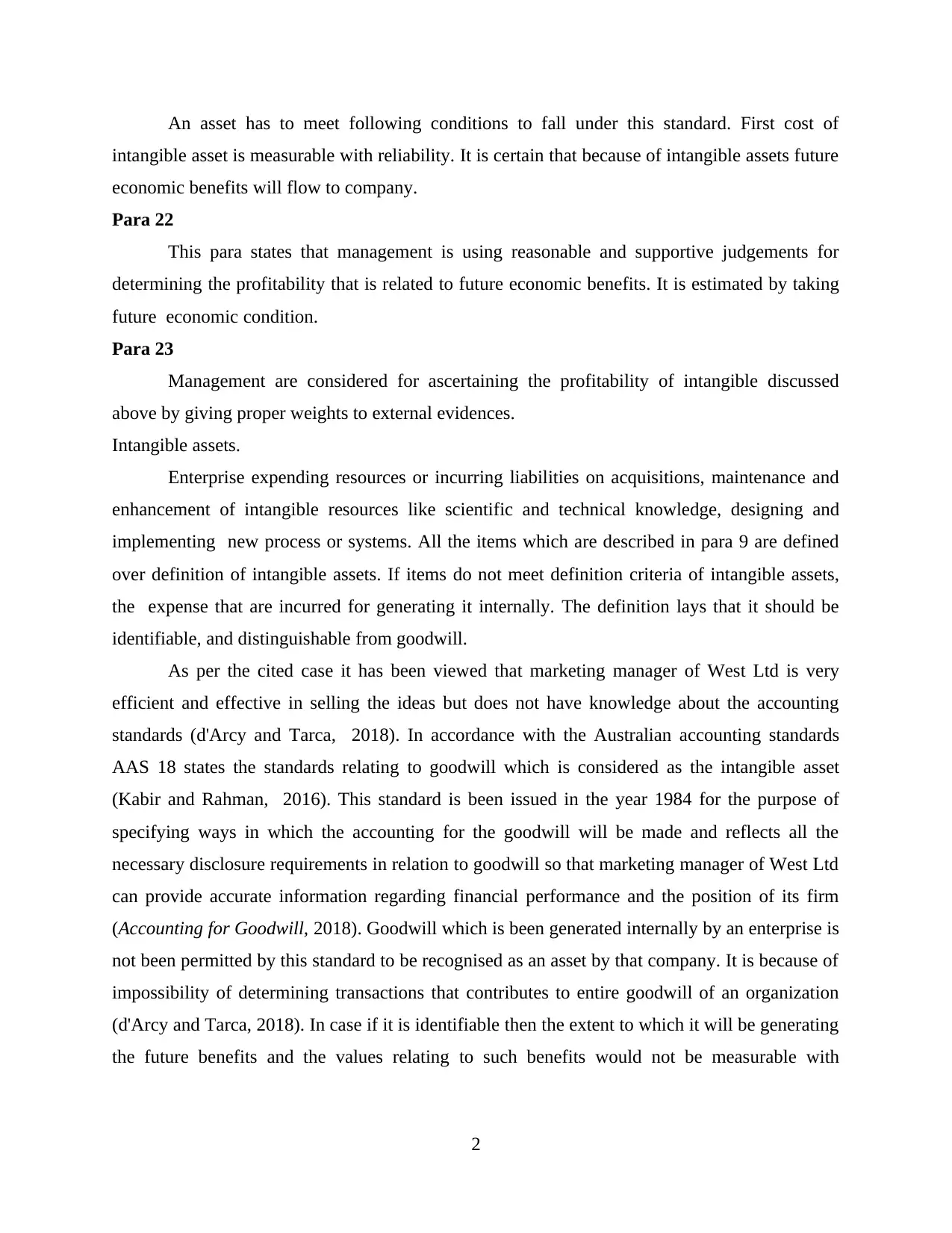
An asset has to meet following conditions to fall under this standard. First cost of
intangible asset is measurable with reliability. It is certain that because of intangible assets future
economic benefits will flow to company.
Para 22
This para states that management is using reasonable and supportive judgements for
determining the profitability that is related to future economic benefits. It is estimated by taking
future economic condition.
Para 23
Management are considered for ascertaining the profitability of intangible discussed
above by giving proper weights to external evidences.
Intangible assets.
Enterprise expending resources or incurring liabilities on acquisitions, maintenance and
enhancement of intangible resources like scientific and technical knowledge, designing and
implementing new process or systems. All the items which are described in para 9 are defined
over definition of intangible assets. If items do not meet definition criteria of intangible assets,
the expense that are incurred for generating it internally. The definition lays that it should be
identifiable, and distinguishable from goodwill.
As per the cited case it has been viewed that marketing manager of West Ltd is very
efficient and effective in selling the ideas but does not have knowledge about the accounting
standards (d'Arcy and Tarca, 2018). In accordance with the Australian accounting standards
AAS 18 states the standards relating to goodwill which is considered as the intangible asset
(Kabir and Rahman, 2016). This standard is been issued in the year 1984 for the purpose of
specifying ways in which the accounting for the goodwill will be made and reflects all the
necessary disclosure requirements in relation to goodwill so that marketing manager of West Ltd
can provide accurate information regarding financial performance and the position of its firm
(Accounting for Goodwill, 2018). Goodwill which is been generated internally by an enterprise is
not been permitted by this standard to be recognised as an asset by that company. It is because of
impossibility of determining transactions that contributes to entire goodwill of an organization
(d'Arcy and Tarca, 2018). In case if it is identifiable then the extent to which it will be generating
the future benefits and the values relating to such benefits would not be measurable with
2
intangible asset is measurable with reliability. It is certain that because of intangible assets future
economic benefits will flow to company.
Para 22
This para states that management is using reasonable and supportive judgements for
determining the profitability that is related to future economic benefits. It is estimated by taking
future economic condition.
Para 23
Management are considered for ascertaining the profitability of intangible discussed
above by giving proper weights to external evidences.
Intangible assets.
Enterprise expending resources or incurring liabilities on acquisitions, maintenance and
enhancement of intangible resources like scientific and technical knowledge, designing and
implementing new process or systems. All the items which are described in para 9 are defined
over definition of intangible assets. If items do not meet definition criteria of intangible assets,
the expense that are incurred for generating it internally. The definition lays that it should be
identifiable, and distinguishable from goodwill.
As per the cited case it has been viewed that marketing manager of West Ltd is very
efficient and effective in selling the ideas but does not have knowledge about the accounting
standards (d'Arcy and Tarca, 2018). In accordance with the Australian accounting standards
AAS 18 states the standards relating to goodwill which is considered as the intangible asset
(Kabir and Rahman, 2016). This standard is been issued in the year 1984 for the purpose of
specifying ways in which the accounting for the goodwill will be made and reflects all the
necessary disclosure requirements in relation to goodwill so that marketing manager of West Ltd
can provide accurate information regarding financial performance and the position of its firm
(Accounting for Goodwill, 2018). Goodwill which is been generated internally by an enterprise is
not been permitted by this standard to be recognised as an asset by that company. It is because of
impossibility of determining transactions that contributes to entire goodwill of an organization
(d'Arcy and Tarca, 2018). In case if it is identifiable then the extent to which it will be generating
the future benefits and the values relating to such benefits would not be measurable with
2
Paraphrase This Document
Need a fresh take? Get an instant paraphrase of this document with our AI Paraphraser
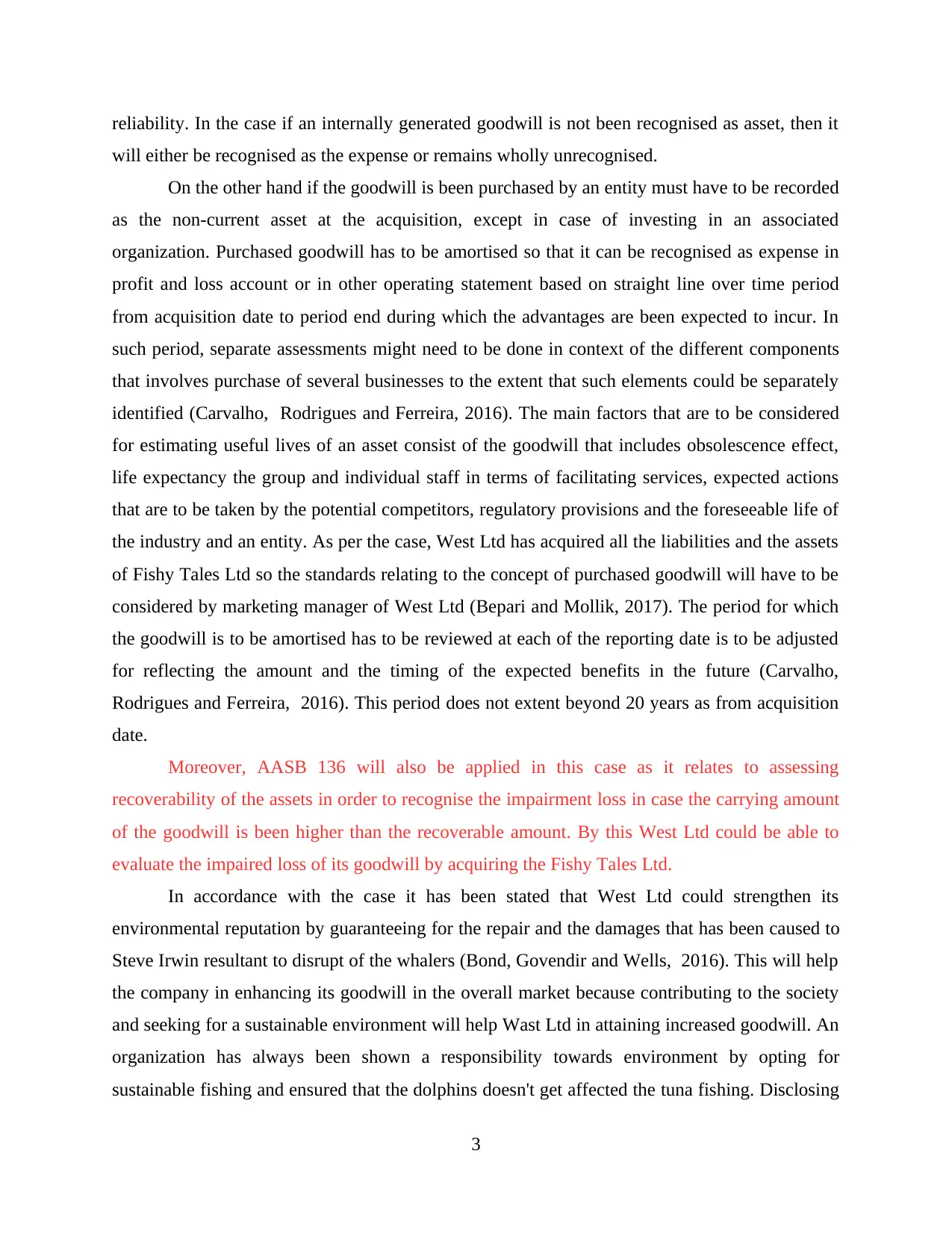
reliability. In the case if an internally generated goodwill is not been recognised as asset, then it
will either be recognised as the expense or remains wholly unrecognised.
On the other hand if the goodwill is been purchased by an entity must have to be recorded
as the non-current asset at the acquisition, except in case of investing in an associated
organization. Purchased goodwill has to be amortised so that it can be recognised as expense in
profit and loss account or in other operating statement based on straight line over time period
from acquisition date to period end during which the advantages are been expected to incur. In
such period, separate assessments might need to be done in context of the different components
that involves purchase of several businesses to the extent that such elements could be separately
identified (Carvalho, Rodrigues and Ferreira, 2016). The main factors that are to be considered
for estimating useful lives of an asset consist of the goodwill that includes obsolescence effect,
life expectancy the group and individual staff in terms of facilitating services, expected actions
that are to be taken by the potential competitors, regulatory provisions and the foreseeable life of
the industry and an entity. As per the case, West Ltd has acquired all the liabilities and the assets
of Fishy Tales Ltd so the standards relating to the concept of purchased goodwill will have to be
considered by marketing manager of West Ltd (Bepari and Mollik, 2017). The period for which
the goodwill is to be amortised has to be reviewed at each of the reporting date is to be adjusted
for reflecting the amount and the timing of the expected benefits in the future (Carvalho,
Rodrigues and Ferreira, 2016). This period does not extent beyond 20 years as from acquisition
date.
Moreover, AASB 136 will also be applied in this case as it relates to assessing
recoverability of the assets in order to recognise the impairment loss in case the carrying amount
of the goodwill is been higher than the recoverable amount. By this West Ltd could be able to
evaluate the impaired loss of its goodwill by acquiring the Fishy Tales Ltd.
In accordance with the case it has been stated that West Ltd could strengthen its
environmental reputation by guaranteeing for the repair and the damages that has been caused to
Steve Irwin resultant to disrupt of the whalers (Bond, Govendir and Wells, 2016). This will help
the company in enhancing its goodwill in the overall market because contributing to the society
and seeking for a sustainable environment will help Wast Ltd in attaining increased goodwill. An
organization has always been shown a responsibility towards environment by opting for
sustainable fishing and ensured that the dolphins doesn't get affected the tuna fishing. Disclosing
3
will either be recognised as the expense or remains wholly unrecognised.
On the other hand if the goodwill is been purchased by an entity must have to be recorded
as the non-current asset at the acquisition, except in case of investing in an associated
organization. Purchased goodwill has to be amortised so that it can be recognised as expense in
profit and loss account or in other operating statement based on straight line over time period
from acquisition date to period end during which the advantages are been expected to incur. In
such period, separate assessments might need to be done in context of the different components
that involves purchase of several businesses to the extent that such elements could be separately
identified (Carvalho, Rodrigues and Ferreira, 2016). The main factors that are to be considered
for estimating useful lives of an asset consist of the goodwill that includes obsolescence effect,
life expectancy the group and individual staff in terms of facilitating services, expected actions
that are to be taken by the potential competitors, regulatory provisions and the foreseeable life of
the industry and an entity. As per the case, West Ltd has acquired all the liabilities and the assets
of Fishy Tales Ltd so the standards relating to the concept of purchased goodwill will have to be
considered by marketing manager of West Ltd (Bepari and Mollik, 2017). The period for which
the goodwill is to be amortised has to be reviewed at each of the reporting date is to be adjusted
for reflecting the amount and the timing of the expected benefits in the future (Carvalho,
Rodrigues and Ferreira, 2016). This period does not extent beyond 20 years as from acquisition
date.
Moreover, AASB 136 will also be applied in this case as it relates to assessing
recoverability of the assets in order to recognise the impairment loss in case the carrying amount
of the goodwill is been higher than the recoverable amount. By this West Ltd could be able to
evaluate the impaired loss of its goodwill by acquiring the Fishy Tales Ltd.
In accordance with the case it has been stated that West Ltd could strengthen its
environmental reputation by guaranteeing for the repair and the damages that has been caused to
Steve Irwin resultant to disrupt of the whalers (Bond, Govendir and Wells, 2016). This will help
the company in enhancing its goodwill in the overall market because contributing to the society
and seeking for a sustainable environment will help Wast Ltd in attaining increased goodwill. An
organization has always been shown a responsibility towards environment by opting for
sustainable fishing and ensured that the dolphins doesn't get affected the tuna fishing. Disclosing
3
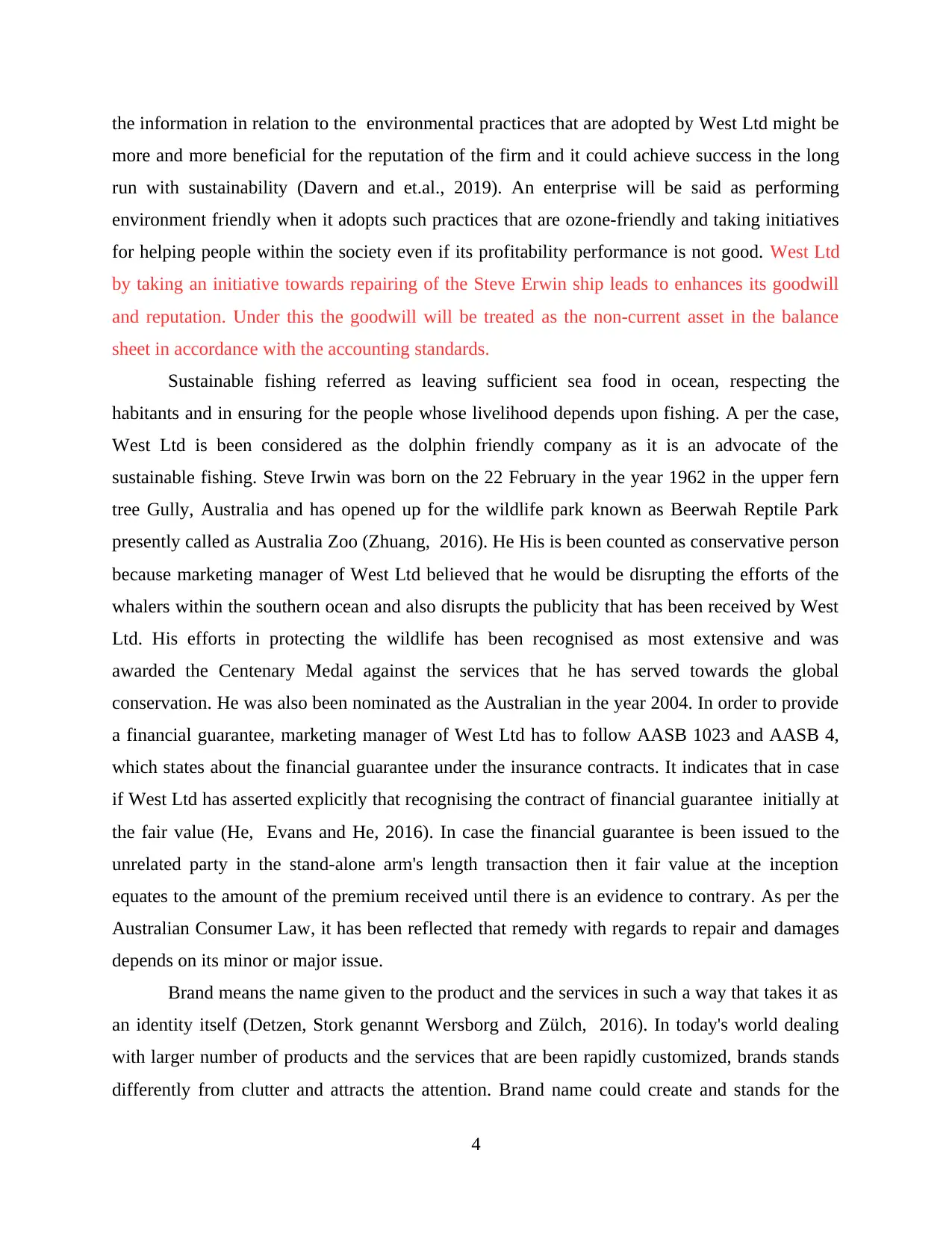
the information in relation to the environmental practices that are adopted by West Ltd might be
more and more beneficial for the reputation of the firm and it could achieve success in the long
run with sustainability (Davern and et.al., 2019). An enterprise will be said as performing
environment friendly when it adopts such practices that are ozone-friendly and taking initiatives
for helping people within the society even if its profitability performance is not good. West Ltd
by taking an initiative towards repairing of the Steve Erwin ship leads to enhances its goodwill
and reputation. Under this the goodwill will be treated as the non-current asset in the balance
sheet in accordance with the accounting standards.
Sustainable fishing referred as leaving sufficient sea food in ocean, respecting the
habitants and in ensuring for the people whose livelihood depends upon fishing. A per the case,
West Ltd is been considered as the dolphin friendly company as it is an advocate of the
sustainable fishing. Steve Irwin was born on the 22 February in the year 1962 in the upper fern
tree Gully, Australia and has opened up for the wildlife park known as Beerwah Reptile Park
presently called as Australia Zoo (Zhuang, 2016). He His is been counted as conservative person
because marketing manager of West Ltd believed that he would be disrupting the efforts of the
whalers within the southern ocean and also disrupts the publicity that has been received by West
Ltd. His efforts in protecting the wildlife has been recognised as most extensive and was
awarded the Centenary Medal against the services that he has served towards the global
conservation. He was also been nominated as the Australian in the year 2004. In order to provide
a financial guarantee, marketing manager of West Ltd has to follow AASB 1023 and AASB 4,
which states about the financial guarantee under the insurance contracts. It indicates that in case
if West Ltd has asserted explicitly that recognising the contract of financial guarantee initially at
the fair value (He, Evans and He, 2016). In case the financial guarantee is been issued to the
unrelated party in the stand-alone arm's length transaction then it fair value at the inception
equates to the amount of the premium received until there is an evidence to contrary. As per the
Australian Consumer Law, it has been reflected that remedy with regards to repair and damages
depends on its minor or major issue.
Brand means the name given to the product and the services in such a way that takes it as
an identity itself (Detzen, Stork genannt Wersborg and Zülch, 2016). In today's world dealing
with larger number of products and the services that are been rapidly customized, brands stands
differently from clutter and attracts the attention. Brand name could create and stands for the
4
more and more beneficial for the reputation of the firm and it could achieve success in the long
run with sustainability (Davern and et.al., 2019). An enterprise will be said as performing
environment friendly when it adopts such practices that are ozone-friendly and taking initiatives
for helping people within the society even if its profitability performance is not good. West Ltd
by taking an initiative towards repairing of the Steve Erwin ship leads to enhances its goodwill
and reputation. Under this the goodwill will be treated as the non-current asset in the balance
sheet in accordance with the accounting standards.
Sustainable fishing referred as leaving sufficient sea food in ocean, respecting the
habitants and in ensuring for the people whose livelihood depends upon fishing. A per the case,
West Ltd is been considered as the dolphin friendly company as it is an advocate of the
sustainable fishing. Steve Irwin was born on the 22 February in the year 1962 in the upper fern
tree Gully, Australia and has opened up for the wildlife park known as Beerwah Reptile Park
presently called as Australia Zoo (Zhuang, 2016). He His is been counted as conservative person
because marketing manager of West Ltd believed that he would be disrupting the efforts of the
whalers within the southern ocean and also disrupts the publicity that has been received by West
Ltd. His efforts in protecting the wildlife has been recognised as most extensive and was
awarded the Centenary Medal against the services that he has served towards the global
conservation. He was also been nominated as the Australian in the year 2004. In order to provide
a financial guarantee, marketing manager of West Ltd has to follow AASB 1023 and AASB 4,
which states about the financial guarantee under the insurance contracts. It indicates that in case
if West Ltd has asserted explicitly that recognising the contract of financial guarantee initially at
the fair value (He, Evans and He, 2016). In case the financial guarantee is been issued to the
unrelated party in the stand-alone arm's length transaction then it fair value at the inception
equates to the amount of the premium received until there is an evidence to contrary. As per the
Australian Consumer Law, it has been reflected that remedy with regards to repair and damages
depends on its minor or major issue.
Brand means the name given to the product and the services in such a way that takes it as
an identity itself (Detzen, Stork genannt Wersborg and Zülch, 2016). In today's world dealing
with larger number of products and the services that are been rapidly customized, brands stands
differently from clutter and attracts the attention. Brand name could create and stands for the
4
⊘ This is a preview!⊘
Do you want full access?
Subscribe today to unlock all pages.

Trusted by 1+ million students worldwide
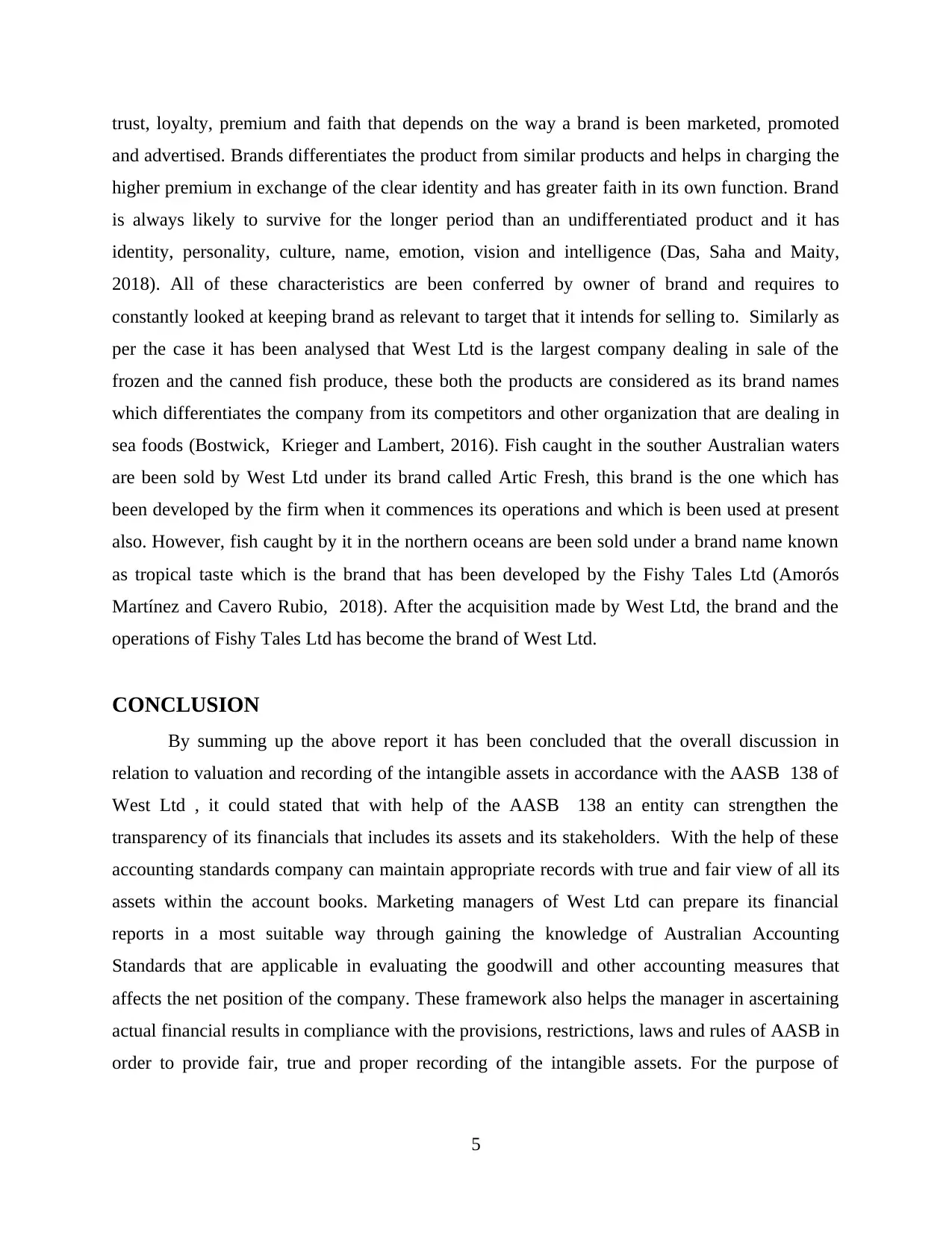
trust, loyalty, premium and faith that depends on the way a brand is been marketed, promoted
and advertised. Brands differentiates the product from similar products and helps in charging the
higher premium in exchange of the clear identity and has greater faith in its own function. Brand
is always likely to survive for the longer period than an undifferentiated product and it has
identity, personality, culture, name, emotion, vision and intelligence (Das, Saha and Maity,
2018). All of these characteristics are been conferred by owner of brand and requires to
constantly looked at keeping brand as relevant to target that it intends for selling to. Similarly as
per the case it has been analysed that West Ltd is the largest company dealing in sale of the
frozen and the canned fish produce, these both the products are considered as its brand names
which differentiates the company from its competitors and other organization that are dealing in
sea foods (Bostwick, Krieger and Lambert, 2016). Fish caught in the souther Australian waters
are been sold by West Ltd under its brand called Artic Fresh, this brand is the one which has
been developed by the firm when it commences its operations and which is been used at present
also. However, fish caught by it in the northern oceans are been sold under a brand name known
as tropical taste which is the brand that has been developed by the Fishy Tales Ltd (Amorós
Martínez and Cavero Rubio, 2018). After the acquisition made by West Ltd, the brand and the
operations of Fishy Tales Ltd has become the brand of West Ltd.
CONCLUSION
By summing up the above report it has been concluded that the overall discussion in
relation to valuation and recording of the intangible assets in accordance with the AASB 138 of
West Ltd , it could stated that with help of the AASB 138 an entity can strengthen the
transparency of its financials that includes its assets and its stakeholders. With the help of these
accounting standards company can maintain appropriate records with true and fair view of all its
assets within the account books. Marketing managers of West Ltd can prepare its financial
reports in a most suitable way through gaining the knowledge of Australian Accounting
Standards that are applicable in evaluating the goodwill and other accounting measures that
affects the net position of the company. These framework also helps the manager in ascertaining
actual financial results in compliance with the provisions, restrictions, laws and rules of AASB in
order to provide fair, true and proper recording of the intangible assets. For the purpose of
5
and advertised. Brands differentiates the product from similar products and helps in charging the
higher premium in exchange of the clear identity and has greater faith in its own function. Brand
is always likely to survive for the longer period than an undifferentiated product and it has
identity, personality, culture, name, emotion, vision and intelligence (Das, Saha and Maity,
2018). All of these characteristics are been conferred by owner of brand and requires to
constantly looked at keeping brand as relevant to target that it intends for selling to. Similarly as
per the case it has been analysed that West Ltd is the largest company dealing in sale of the
frozen and the canned fish produce, these both the products are considered as its brand names
which differentiates the company from its competitors and other organization that are dealing in
sea foods (Bostwick, Krieger and Lambert, 2016). Fish caught in the souther Australian waters
are been sold by West Ltd under its brand called Artic Fresh, this brand is the one which has
been developed by the firm when it commences its operations and which is been used at present
also. However, fish caught by it in the northern oceans are been sold under a brand name known
as tropical taste which is the brand that has been developed by the Fishy Tales Ltd (Amorós
Martínez and Cavero Rubio, 2018). After the acquisition made by West Ltd, the brand and the
operations of Fishy Tales Ltd has become the brand of West Ltd.
CONCLUSION
By summing up the above report it has been concluded that the overall discussion in
relation to valuation and recording of the intangible assets in accordance with the AASB 138 of
West Ltd , it could stated that with help of the AASB 138 an entity can strengthen the
transparency of its financials that includes its assets and its stakeholders. With the help of these
accounting standards company can maintain appropriate records with true and fair view of all its
assets within the account books. Marketing managers of West Ltd can prepare its financial
reports in a most suitable way through gaining the knowledge of Australian Accounting
Standards that are applicable in evaluating the goodwill and other accounting measures that
affects the net position of the company. These framework also helps the manager in ascertaining
actual financial results in compliance with the provisions, restrictions, laws and rules of AASB in
order to provide fair, true and proper recording of the intangible assets. For the purpose of
5
Paraphrase This Document
Need a fresh take? Get an instant paraphrase of this document with our AI Paraphraser
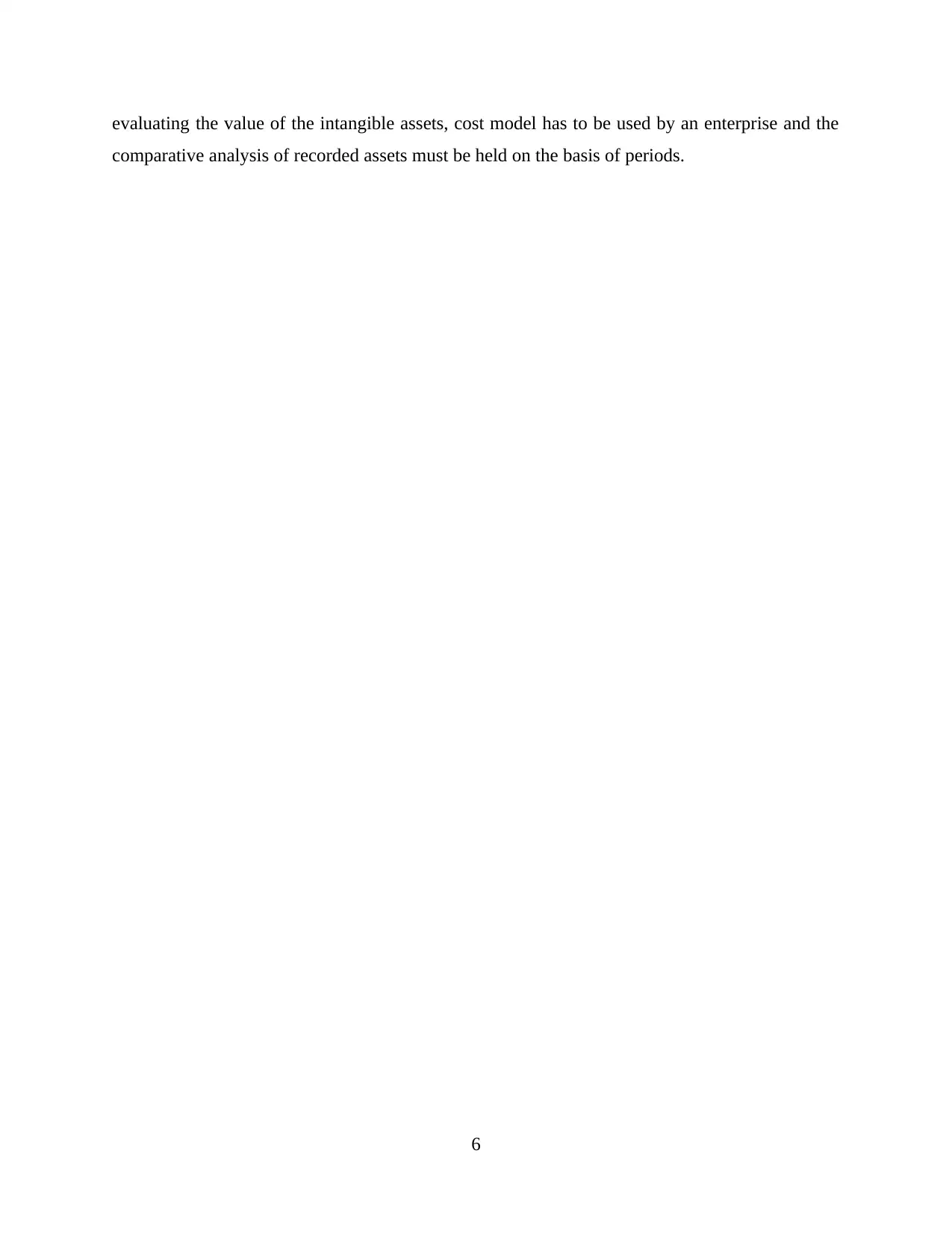
evaluating the value of the intangible assets, cost model has to be used by an enterprise and the
comparative analysis of recorded assets must be held on the basis of periods.
6
comparative analysis of recorded assets must be held on the basis of periods.
6
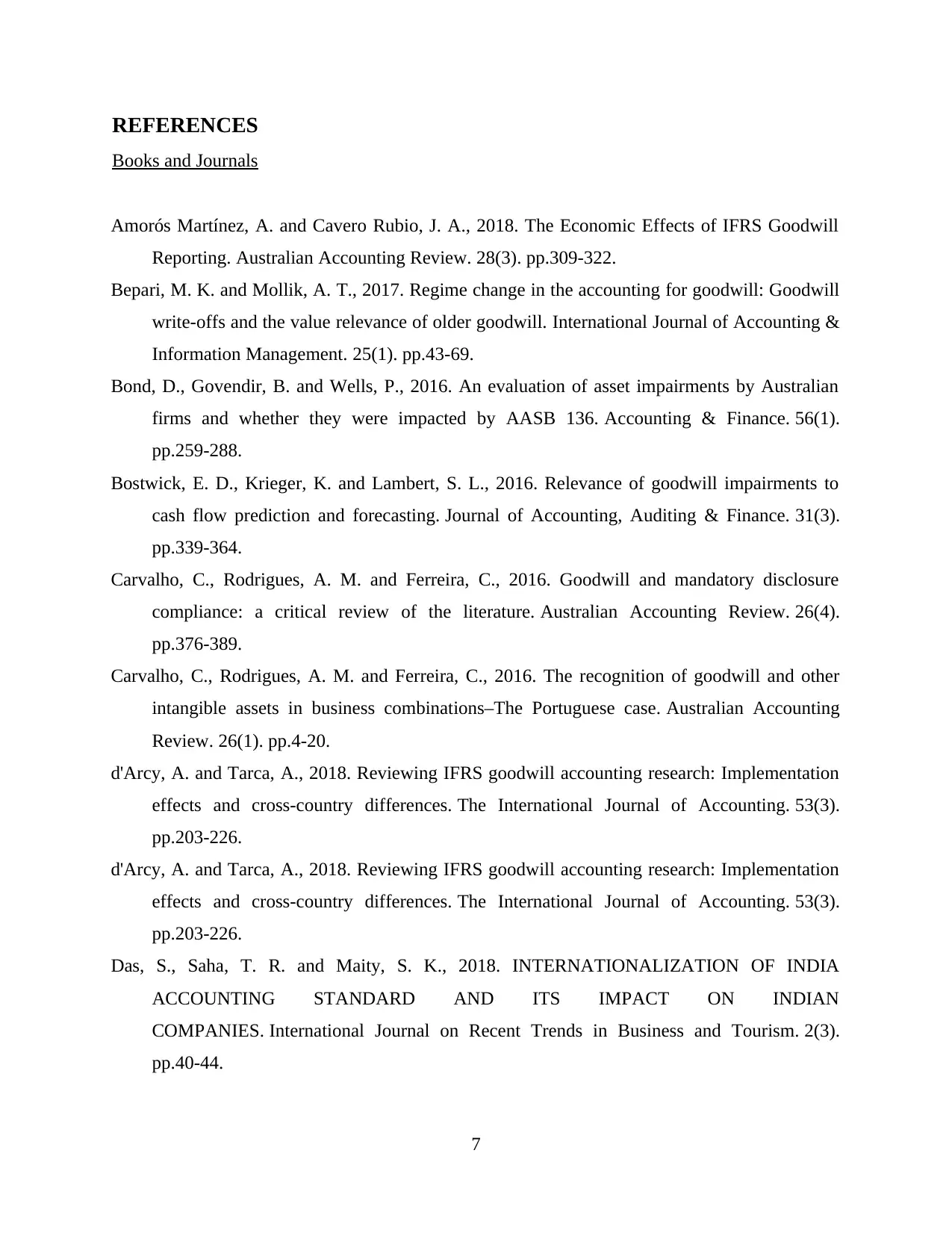
REFERENCES
Books and Journals
Amorós Martínez, A. and Cavero Rubio, J. A., 2018. The Economic Effects of IFRS Goodwill
Reporting. Australian Accounting Review. 28(3). pp.309-322.
Bepari, M. K. and Mollik, A. T., 2017. Regime change in the accounting for goodwill: Goodwill
write-offs and the value relevance of older goodwill. International Journal of Accounting &
Information Management. 25(1). pp.43-69.
Bond, D., Govendir, B. and Wells, P., 2016. An evaluation of asset impairments by Australian
firms and whether they were impacted by AASB 136. Accounting & Finance. 56(1).
pp.259-288.
Bostwick, E. D., Krieger, K. and Lambert, S. L., 2016. Relevance of goodwill impairments to
cash flow prediction and forecasting. Journal of Accounting, Auditing & Finance. 31(3).
pp.339-364.
Carvalho, C., Rodrigues, A. M. and Ferreira, C., 2016. Goodwill and mandatory disclosure
compliance: a critical review of the literature. Australian Accounting Review. 26(4).
pp.376-389.
Carvalho, C., Rodrigues, A. M. and Ferreira, C., 2016. The recognition of goodwill and other
intangible assets in business combinations–The Portuguese case. Australian Accounting
Review. 26(1). pp.4-20.
d'Arcy, A. and Tarca, A., 2018. Reviewing IFRS goodwill accounting research: Implementation
effects and cross-country differences. The International Journal of Accounting. 53(3).
pp.203-226.
d'Arcy, A. and Tarca, A., 2018. Reviewing IFRS goodwill accounting research: Implementation
effects and cross-country differences. The International Journal of Accounting. 53(3).
pp.203-226.
Das, S., Saha, T. R. and Maity, S. K., 2018. INTERNATIONALIZATION OF INDIA
ACCOUNTING STANDARD AND ITS IMPACT ON INDIAN
COMPANIES. International Journal on Recent Trends in Business and Tourism. 2(3).
pp.40-44.
7
Books and Journals
Amorós Martínez, A. and Cavero Rubio, J. A., 2018. The Economic Effects of IFRS Goodwill
Reporting. Australian Accounting Review. 28(3). pp.309-322.
Bepari, M. K. and Mollik, A. T., 2017. Regime change in the accounting for goodwill: Goodwill
write-offs and the value relevance of older goodwill. International Journal of Accounting &
Information Management. 25(1). pp.43-69.
Bond, D., Govendir, B. and Wells, P., 2016. An evaluation of asset impairments by Australian
firms and whether they were impacted by AASB 136. Accounting & Finance. 56(1).
pp.259-288.
Bostwick, E. D., Krieger, K. and Lambert, S. L., 2016. Relevance of goodwill impairments to
cash flow prediction and forecasting. Journal of Accounting, Auditing & Finance. 31(3).
pp.339-364.
Carvalho, C., Rodrigues, A. M. and Ferreira, C., 2016. Goodwill and mandatory disclosure
compliance: a critical review of the literature. Australian Accounting Review. 26(4).
pp.376-389.
Carvalho, C., Rodrigues, A. M. and Ferreira, C., 2016. The recognition of goodwill and other
intangible assets in business combinations–The Portuguese case. Australian Accounting
Review. 26(1). pp.4-20.
d'Arcy, A. and Tarca, A., 2018. Reviewing IFRS goodwill accounting research: Implementation
effects and cross-country differences. The International Journal of Accounting. 53(3).
pp.203-226.
d'Arcy, A. and Tarca, A., 2018. Reviewing IFRS goodwill accounting research: Implementation
effects and cross-country differences. The International Journal of Accounting. 53(3).
pp.203-226.
Das, S., Saha, T. R. and Maity, S. K., 2018. INTERNATIONALIZATION OF INDIA
ACCOUNTING STANDARD AND ITS IMPACT ON INDIAN
COMPANIES. International Journal on Recent Trends in Business and Tourism. 2(3).
pp.40-44.
7
⊘ This is a preview!⊘
Do you want full access?
Subscribe today to unlock all pages.

Trusted by 1+ million students worldwide
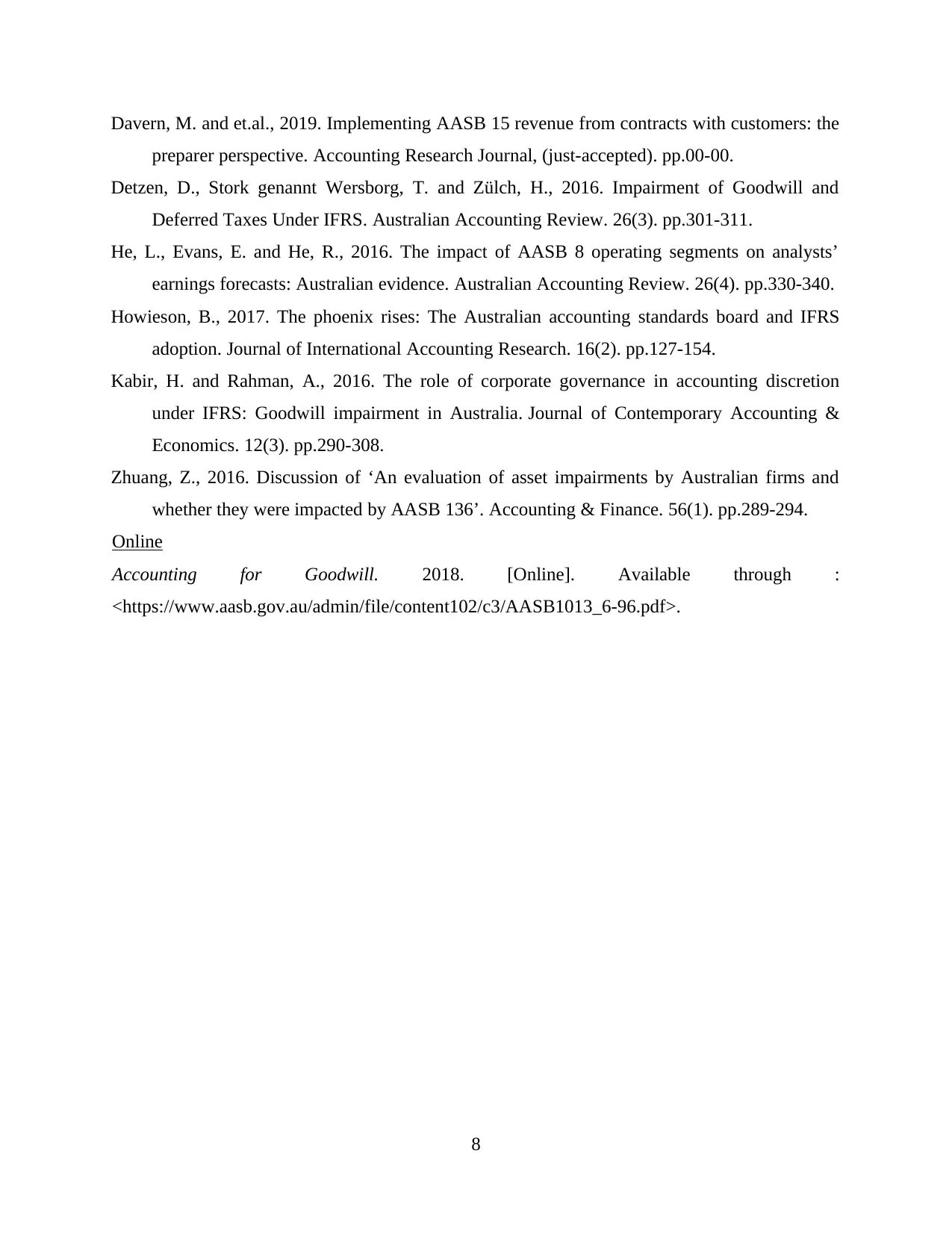
Davern, M. and et.al., 2019. Implementing AASB 15 revenue from contracts with customers: the
preparer perspective. Accounting Research Journal, (just-accepted). pp.00-00.
Detzen, D., Stork genannt Wersborg, T. and Zülch, H., 2016. Impairment of Goodwill and
Deferred Taxes Under IFRS. Australian Accounting Review. 26(3). pp.301-311.
He, L., Evans, E. and He, R., 2016. The impact of AASB 8 operating segments on analysts’
earnings forecasts: Australian evidence. Australian Accounting Review. 26(4). pp.330-340.
Howieson, B., 2017. The phoenix rises: The Australian accounting standards board and IFRS
adoption. Journal of International Accounting Research. 16(2). pp.127-154.
Kabir, H. and Rahman, A., 2016. The role of corporate governance in accounting discretion
under IFRS: Goodwill impairment in Australia. Journal of Contemporary Accounting &
Economics. 12(3). pp.290-308.
Zhuang, Z., 2016. Discussion of ‘An evaluation of asset impairments by Australian firms and
whether they were impacted by AASB 136’. Accounting & Finance. 56(1). pp.289-294.
Online
Accounting for Goodwill. 2018. [Online]. Available through :
<https://www.aasb.gov.au/admin/file/content102/c3/AASB1013_6-96.pdf>.
8
preparer perspective. Accounting Research Journal, (just-accepted). pp.00-00.
Detzen, D., Stork genannt Wersborg, T. and Zülch, H., 2016. Impairment of Goodwill and
Deferred Taxes Under IFRS. Australian Accounting Review. 26(3). pp.301-311.
He, L., Evans, E. and He, R., 2016. The impact of AASB 8 operating segments on analysts’
earnings forecasts: Australian evidence. Australian Accounting Review. 26(4). pp.330-340.
Howieson, B., 2017. The phoenix rises: The Australian accounting standards board and IFRS
adoption. Journal of International Accounting Research. 16(2). pp.127-154.
Kabir, H. and Rahman, A., 2016. The role of corporate governance in accounting discretion
under IFRS: Goodwill impairment in Australia. Journal of Contemporary Accounting &
Economics. 12(3). pp.290-308.
Zhuang, Z., 2016. Discussion of ‘An evaluation of asset impairments by Australian firms and
whether they were impacted by AASB 136’. Accounting & Finance. 56(1). pp.289-294.
Online
Accounting for Goodwill. 2018. [Online]. Available through :
<https://www.aasb.gov.au/admin/file/content102/c3/AASB1013_6-96.pdf>.
8
1 out of 10
Related Documents
Your All-in-One AI-Powered Toolkit for Academic Success.
+13062052269
info@desklib.com
Available 24*7 on WhatsApp / Email
![[object Object]](/_next/static/media/star-bottom.7253800d.svg)
Unlock your academic potential
Copyright © 2020–2025 A2Z Services. All Rights Reserved. Developed and managed by ZUCOL.





